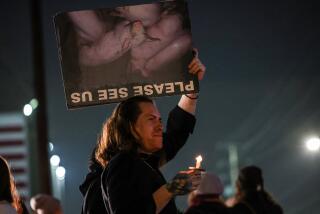Donner Party cannibalism -- it’s still true
A lot of headline writers had a field day in the middle of April, putting toppers on stories suggesting that members of the Donner Party might not have engaged in cannibalism: “Oops,” they wrote, and “Sorry, folks.”
The claim, based on a university news release, was obviously a historical shocker sure to get people’s attention — and yet it was grossly misleading, if not flat wrong.
As a former journalist now working at a university, I’m not sure whether I’m more appalled at the performance of the Fourth Estate or the academy. Here is what happened.
Appalachian State University in Boone, N.C., put out a release describing the work of Gwen Robbins, a professor of anthropology. She is part of a team that excavated one of the Donner Party sites a few years ago. Robbins analyzed bone fragments found at the site of the cooking hearth, and she is ready to release her findings.
Her discovery is that, among the fragments she examined, none is human. This echoes earlier, more preliminary findings by the same team, and is in no way surprising.
Enter Appalachian State’s PR team. Their initial release said that Robbins’ research “finds there is no evidence of cannibalism among the 84 members of the Donner Party who were trapped by a snowstorm in the Sierra Nevada mountains in the mid-1840s.”
The media took it from there, reporting the shocking news that the most famous case of cannibalism in American history could well be a myth. Even a blogger at the majestic New York Times was taken in, throwing up a fanciful post headlined “No Cannibalism Among the Donner Party?”
One critical thing to understand is that the Donner Party was stranded at multiple locations. Most members of the party were trapped at Donner Lake; others were huddled at a site called Alder Creek, about seven miles back on the trail. As the months-long drama played out, some who tried to escape became trapped again and perished along the way.
Robbins analyzed bone fragments found only at the Alder Creek location. Indeed, some of the Donner sites have never been located and thus cannot be excavated.
Understanding the limited nature of Robbins’ research is important. When the initial Appalachian State news release claimed that Robbins’ research found “no evidence of cannibalism among the 84 members of the Donner Party,” it was really pulling a fast one. Robbins’ research has nothing to do with the experiences of most members of the party. They weren’t trapped at the site she and her colleagues excavated.
Based on the comments of the survivors, there simply is no rational dispute about cannibalism at the other Donner Party sites. People at those locations stayed alive by eating the bodies of the dead — an act of necessity and courage.
In other words, even if there was no cannibalism at Alder Creek, there was still cannibalism in the tale of the Donner Party.
And with regard to the Alder Creek site, Robbins’ findings offer less than meets the eye, or at least less than Appalachian State wanted to claim.
Robbins tested 55 bone fragments that had not been studied when the team’s preliminary findings were released a few years ago. The 55 new fragments proved to be cattle, deer, horse and dog. There were no human fragments, just as there had not been among the original 30 fragments analyzed a few years ago.
Then the Appalachian State release added this: “A power analysis indicated that, statistically, [researchers] can be 70 percent confident that if cannibalism made up a small fraction of the diet (less than 1 percent) at the site in the last few weeks of occupation, and if humans were processed in the same way animals were processed, at least one of the 85 bone fragments examined would be human.”
That is sophistry fobbed off as statistical analysis. The key phrase is “if humans were processed in the same way animals were processed.” In all likelihood, they were not.
In most cases of survival cannibalism, people eat the flesh first. The bones are only “processed” — a decorous word for cooked — when all the flesh is gone.
If cannibalism occurred at the Alder Creek site, it probably came near the end of the entrapment over a fairly short span of time. It’s highly likely that human bones were not “processed” at all. The flesh was simply sliced away and eaten, either cooked or uncooked. And there is not one bit of disagreement that uncooked bone would have disintegrated long ago.
I have no idea whether Robbins approved or even saw her university’s original news release before it was disseminated. Appalachian State has since posted a much-revised release that avoids the blunders of the original, and Robbins has presented her findings to her fellow scientists at an academic conference.
But I hope that Robbins, along with excavation team leaders Kelly Dixon of the University of Montana and Julie Schablitsky of the University of Oregon, also find a more popular public forum in which to set the record straight. To her credit, Kristin Johnson, the team’s expert on Donner Party history, has already attempted to do so on her blog.
If the scientists and their universities don’t candidly describe the limitations of their findings, they will, sadly, defeat the purpose of their research. They set out to clarify the historical record. It would be a pity if their work only muddied it all the more.
Ethan Rarick is the author of “Desperate Passage: The Donner Party’s Perilous Journey West,” published by Oxford University Press.
More to Read
Sign up for Essential California
The most important California stories and recommendations in your inbox every morning.
You may occasionally receive promotional content from the Los Angeles Times.










